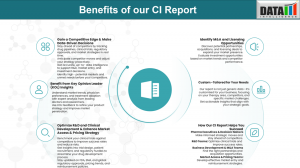Rett Syndrome Drug Race Intensifies as Gene Therapies Challenge Trofinetide’s Market Reign | Competitive Intelligence
Rett syndrome care is evolving as DAYBUE leads the market and next-gen therapies like gene and neuroplasticity agents aim to redefine treatment standards
The therapeutic ecosystem for Rett syndrome, a rare genetic neurodevelopmental disorder that primarily affects females, is undergoing a significant transformation. Marked by severe impairments in communication, motor function, and cognition, Rett syndrome stems from mutations in the MECP2 gene. Until recently, patients and caregivers had no approved treatment options—until Acadia Pharmaceuticals’ trofinetide (DAYBUE) broke new ground as the first FDA-approved therapy for Rett syndrome.
With U.S. approval in hand and European regulatory review underway, trofinetide currently dominates the landscape. However, the competitive field is far from settled. A wave of emerging therapies—ranging from small-molecule neuroplasticity enhancers to gene therapies targeting the MECP2 defect—is gaining momentum, threatening to disrupt trofinetide’s early lead.
Book Your CI Consultation Call: https://www.datamintelligence.com/strategic-insights/ci/rett-syndrome
Beyond Symptom Management: Emerging Therapies Raise the Bar
While trofinetide offers meaningful symptomatic improvement, particularly in communication and motor functions, its benefits plateau after approximately 12 weeks and are associated with moderate gastrointestinal side effects. Next-generation therapies are now targeting more durable, transformative outcomes—especially those that aim to modify the disease course.
Key Players and Competitive Differentiators:
- Bionetide (NA-921) by Biomed Industries seeks to improve upon trofinetide by enhancing the IGF-1 pathway through oral administration with an improved safety profile. It’s viewed as a potential cost-effective, safer alternative, but large-scale efficacy data is still pending.
- Blarcamesine (ANAVEX-2-73) from Anavex Life Sciences is focused on neuroplasticity and cognitive improvement, backed by biomarker-driven trials. This candidate holds broader potential across CNS disorders and is poised to challenge trofinetide through its multi-pathway activity.
- TSHA-102 by Taysha Gene Therapies and NGN-401 from Neurogene represent the next frontier: gene therapy. These programs aim to correct or replace defective MECP2 function, offering the possibility of one-time, durable benefit. However, safety, delivery challenges, and recent dosing concerns—especially in high-dose cohorts of NGN-401—must be addressed.
- NTI164 by Neurotech offers a plant-derived complementary approach, which may serve as a behavioral adjunct but lacks the robust efficacy or durability needed for primary therapy positioning.
Target Opportunity Profile (TOP): Redefining Success Metrics in Rett Syndrome
Emerging therapies will be measured against a new, higher benchmark. The Target Opportunity Profile (TOP) outlines the key features that future drugs must demonstrate to justify their place in the evolving Rett market:
- Superior Efficacy: Sustained functional gains—both motor and cognitive—lasting 6–12 months or longer, will be critical. Symptom control is no longer sufficient unless it surpasses trofinetide in depth or duration.
- Exceptional Safety: Particularly for pediatric patients, systemic tolerability and absence of serious adverse effects are non-negotiable. Gene therapies must be backed by clear safety validation over time.
- Mechanistic Differentiation: Therapies correcting the MECP2 defect (via gene therapy or regulation) are the most promising from a disease-modification standpoint, differentiating clearly from IGF-1 analogs like trofinetide.
- Administration & Adherence: While oral, once-daily delivery remains the gold standard for compliance, gene therapies can compete if they offer long-interval or one-time dosing with durable outcomes.
- Precision Strategy: Biomarker-driven patient selection and trial endpoints (e.g., EEG, MECP2 expression, neuroimaging) will improve regulatory and payer alignment, and optimize clinical success.
- Pricing Leverage: At ~$375,000/year, trofinetide has set a high pricing ceiling. Future therapies must either justify a higher price with curative potential or deliver comparable efficacy with improved tolerability at a lower cost.
Strategic Implications: A Market in Transition
While Acadia’s DAYBUE currently leads with regulatory approval and first-mover advantage, the therapeutic bar in Rett syndrome is rising fast. The next 12–24 months will be critical, as late-stage candidates like Blarcamesine and Bionetide inch closer to potential commercial viability, and gene therapy platforms gather long-term efficacy and safety data.
Download Free CI sample Report: https://www.datamintelligence.com/strategic-insights/sample/rett-syndrome
Key strategic questions facing developers and investors now include:
- Can gene therapies overcome early safety setbacks and deliver durable, disease-modifying results?
- Will oral small molecules achieve enough differentiation in efficacy or tolerability to displace trofinetide?
- How will biomarker-based precision medicine reshape clinical trial success and payer reimbursement strategies?
Read More CI Reports:
1. Thyroid Eye Disease | CI Insights
2. Polycythemia Vera | CI Insights
Sai Kumar
DataM Intelligence 4market Research LLP
+1 877-441-4866
sai.k|datamintelligence.com| |sai.k|datamintelligence.com
Visit us on social media:
LinkedIn
X
Legal Disclaimer:
EIN Presswire provides this news content "as is" without warranty of any kind. We do not accept any responsibility or liability for the accuracy, content, images, videos, licenses, completeness, legality, or reliability of the information contained in this article. If you have any complaints or copyright issues related to this article, kindly contact the author above.
Wearable Diabetes Device Market is Projected to Reach USD 42.1 Billion, with a Robust 9.5% CAGR Till 2035
Vacuum Therapy Device Market is Expected to Hit USD 3.5 Billion by 2035 with a Remarkable 5.01% CAGR
Wastewater Treatment Chemicals Market Top Competitors Analysis Report 2025
Więcej ważnych informacji
 Jedynka Newserii
Jedynka Newserii

 Jedynka Newserii
Jedynka Newserii

Farmacja

Nowy pakiet farmaceutyczny ma wyrównać szanse pacjentów w całej Unii. W Polsce na niektóre leki czeka się ponad dwa lata dłużej niż w Niemczech
Jeszcze pod przewodnictwem Polski Rada UE uzgodniła stanowisko w sprawie pakietu farmaceutycznego – największej reformy prawa lekowego od 20 lat. Ma on skrócić różnice w dostępie do terapii między krajami członkowskimi, które dziś sięgają nawet dwóch–trzech lat. W Unii Europejskiej wciąż brakuje terapii na ponad 6 tys. chorób rzadkich, a niedobory obejmują również leki ratujące życie. Nowe przepisy mają zapewnić szybszy dostęp do leków, wzmocnić konkurencyjność branży oraz zabezpieczyć dostawy.
Handel
Wzrost wydobycia ropy naftowej nie wpłynie na spadek cen surowca. Kierowcy jesienią zapłacą więcej za olej napędowy

Sierpień jest trzecim z rzędu miesiącem, gdy osiem krajów OPEC+ zwiększa podaż ropy naftowej na globalnym rynku; we wrześniu nastąpi kolejna zwyżka. Kraje OPEC, zwłaszcza Arabia Saudyjska, chcą w ten sposób odzyskać udziały w rynku utracone na skutek zmniejszenia wydobycia od 2022 roku, głównie na rzecz amerykańskich producentów. Nie należy się jednak spodziewać spadku cen ropy, gdyż popyt powinien być wysoki, a pod znakiem zapytania stoi dostępność ropy z Rosji. Nie zmienia to faktu, że jesienią ceny paliw na stacjach zazwyczaj rosną, a w największym stopniu podwyżki dotyczyć będą diesla.
Nauka
Szacowanie rzeczywistej liczby użytkowników miast dużym wyzwaniem. Statystycy wykorzystują dane z nowoczesnych źródeł

Różnica między liczbą rezydentów a rzeczywistą liczbą osób codziennie przebywających w Warszawie może sięgać nawet niemal pół miliona. Rozbieżności są dostrzegalne przede wszystkim w dużych miastach i ich obszarach funkcjonalnych. Precyzyjne dane populacyjne są tymczasem niezbędne w kształtowaniu usług społecznych i zdrowotnych, edukacyjnych, opiekuńczych, a także w planowaniu inwestycji infrastrukturalnych. W statystyce coraz częściej dane z oficjalnych źródeł, takich jak Zakład Ubezpieczeń Społecznych, są uzupełniane o te pochodzące od operatorów sieci komórkowych czy kart płatniczych.
Partner serwisu
Szkolenia

Akademia Newserii
Akademia Newserii to projekt, w ramach którego najlepsi polscy dziennikarze biznesowi, giełdowi oraz lifestylowi, a także szkoleniowcy z wieloletnim doświadczeniem dzielą się swoją wiedzą nt. pracy z mediami.









.gif)

 |
| |
| |
|